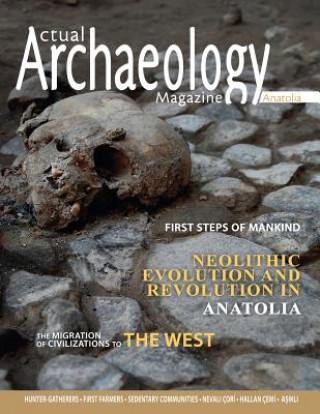
Code: 12860429
Actual Archaeology
by Ayse Tatar, Murat Nagis
The Paleolithic Period, known to the public as "Old Stone Age", was a long period of time when mankind lived as mobile hunter-gatherers for almost two million years. They were living like other beings do in nature without produci ... more
- Language:
 English
English - Binding: Paperback
- Number of pages: 100
Publisher: Iboo, 2016
- More about this

You might also like
-

Race Distinctions in American Law.
139.87 zł -5 % -

Ride: Competing for the Cup
114.56 zł -

Persistence of Modernism
251.29 zł -

Interchange Level 1A Workbook
111.01 zł
Availability alert
Enter your e-mail address and once book will be available,
we will send you a message. It's that simple.
More about Actual Archaeology
 Book synopsis
Book synopsis
The Paleolithic Period, known to the public as "Old Stone Age", was a long period of time when mankind lived as mobile hunter-gatherers for almost two million years. They were living like other beings do in nature without producing, but instead only with using, viewing and transferring the opportunities that the nature offered them. During this long period of time, mankind's knowledge about nature increased and mankind learned how to manage nature. At the end of the Last Ice Age, almost 12 millennia ago, the climate began to get warm in Mesopotamia in the region between the Tigris and the Euphrates Rivers and the region was filled with a great variety of animals, plants and dried fruits. After the Paleolithic Period, the Neolithic Period, also called the "New Stone Age" began, when the hunter-gatherers who knew plants in nature well decided to produce their own plants and settled down. After all, the need for more food due to the increasing population caused social and technological changes to occur in the processes of food cultivation and domestication of wild animals. This breakthrough, which was the result of mankind's cultural development and the success of men against nature is called the "Neolithic Revolution". In this process, the seeds of civilizations were planted.The Paleolithic Period, known to the public as "Old Stone Age", was a long period of time when mankind lived as mobile hunter-gatherers for almost two million years. They were living like other beings do in nature without producing, but instead only with using, viewing and transferring the opportunities that the nature offered them. During this long period of time, mankind's knowledge about nature increased and mankind learned how to manage nature. At the end of the Last Ice Age, almost 12 millennia ago, the climate began to get warm in Mesopotamia in the region between the Tigris and the Euphrates Rivers and the region was filled with a great variety of animals, plants and dried fruits. After the Paleolithic Period, the Neolithic Period, also called the "New Stone Age" began, when the hunter-gatherers who knew plants in nature well decided to produce their own plants and settled down. After all, the need for more food due to the increasing population caused social and technological changes to occur in the processes of food cultivation and domestication of wild animals. This breakthrough, which was the result of mankind's cultural development and the success of men against nature is called the "Neolithic Revolution". In this process, the seeds of civilizations were planted.
 Book details
Book details
- Full title: Actual Archaeology
- Subtitle: First Steps of Mankind
- Author: Ayse Tatar, Murat Nagis
- Language:
 English
English - Binding: Paperback
- Number of pages: 100
- EAN: 9786056660764
- ISBN: 6056660761
- ID: 12860429
- Publisher: Iboo
- Weight: 254 g
- Dimensions: 279 × 216 × 5 mm
- Date of publishing: 31. May 2016
Trending among others
-

Dune
35.21 zł -33 % -

Haunting Adeline
124.88 zł -2 % -

Berserk Deluxe Volume 2
213.64 zł -1 % -

White Nights
11.22 zł -26 % -

Powerless
47.46 zł -14 % -

Atomic Habits
59.50 zł -26 % -

Dune Messiah
46.55 zł -3 % -

Berserk Deluxe Volume 3
221.23 zł -

One Day
32.78 zł -36 % -

Berserk Deluxe Volume 1
212.83 zł -2 % -

Iron Flame
63.24 zł -26 % -

Surrounded by Idiots
37.94 zł -26 % -

Harry Potter and the Prisoner of Azkaban (Minalima Edition)
171.23 zł -2 % -

Gravity Falls Journal 3
90.06 zł -

Heaven Official's Blessing: Tian Guan Ci Fu (Novel) Vol. 1
89.46 zł -1 % -

The Creative Act
100.69 zł -15 % -

Dune
38.25 zł -38 % -

Hunting Adeline
130.75 zł -1 % -

A Little Life
48.77 zł -12 % -

Children of Dune
46.95 zł -2 % -

Heaven Official's Blessing: Tian Guan Ci Fu (Novel) Vol. 2
96.24 zł -

Bungo Stray Dogs, Vol. 8 (light novel)
64.66 zł -6 % -

Percy Jackson and the Olympians 5 Book Paperback Boxed Set
194 zł -1 % -

Solo Leveling, Vol. 1
88.95 zł -1 % -

The Prisoner's Throne
43.61 zł -15 % -

Court of Thorns and Roses
43.61 zł -15 % -

Cry Baby Coloring Book
48.47 zł -

Fourth Wing
72.25 zł -15 % -

Icebreaker
34.30 zł -28 % -

Berserk Deluxe Volume 6
219 zł -

Avatar, the Last Airbender: The Kyoshi Novels (Box Set)
170.02 zł -2 % -

The 48 Laws of Power
101.70 zł -13 % -

House of Leaves
86.22 zł -33 % -

Twisted Lies
36.93 zł -28 % -

Dune Messiah
47.76 zł -23 % -

No Longer Human
54.34 zł -21 % -

48 Laws Of Power
86.52 zł -14 % -

Twisted Games
37.94 zł -26 % -

Caraval Paperback Boxed Set
176.39 zł -3 % -

Solo Leveling, Vol. 2
75.39 zł -23 % -

Open Circuits
170.42 zł -2 % -

Berserk Deluxe Volume 5
218.90 zł -

Heaven Official's Blessing: Tian Guan Ci Fu (Novel) Vol. 3
84.30 zł -7 % -

Berserk Deluxe Volume 4
222.85 zł -23 % -

Court of Mist and Fury
36.73 zł -26 % -

SOLO LEVELING V08
88.85 zł -2 % -

English File Upper Intermediate Multipack A (4th)
93.50 zł -1 % -

CHAINSAW MAN V14
34.10 zł -26 % -

Before the Coffee Gets Cold
34.10 zł -26 %
safisfied customers
Since 2008, we have served long line of book lovers, but each of them was always on the first place.
Copyright! ©2008-24 libristo.pl All rights reservedPrivacyPoučení o cookies



 21 million books
21 million books Delivery 12.99 zł
Delivery 12.99 zł (32) 444 93 66 (8-15.30h)
(32) 444 93 66 (8-15.30h)